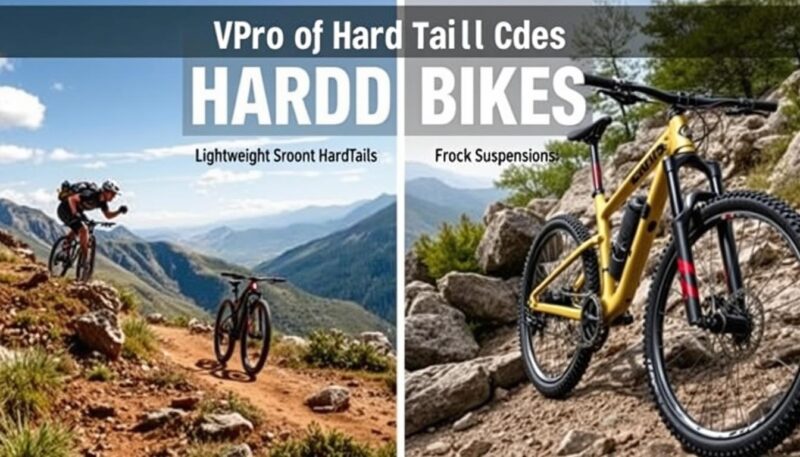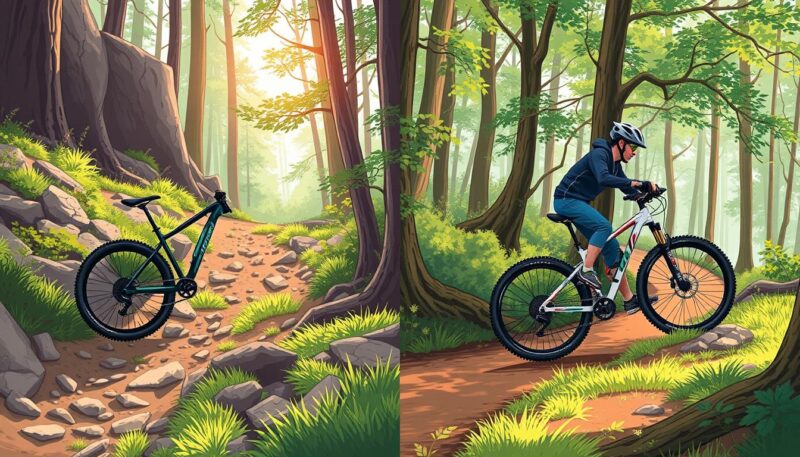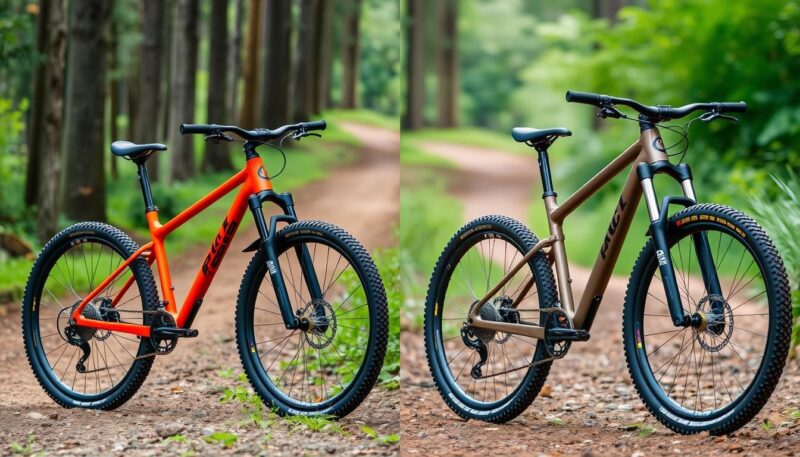When it comes to mountain biking, one of the most pivotal choices you will face is deciding between a hardtail and a full suspension bike. The hardtail vs full suspension debate goes beyond mere preference; it touches on your riding style, the terrain you’ll frequent, and your overall biking experience. While hardtails are often praised for their simplicity and lightweight design, full suspension bikes offer a level of comfort and control that many riders have come to appreciate.
The decision-making process can be intricate, especially with differences in price, performance, and suitability for various terrains. For instance, one cyclist made the leap to a full suspension bike despite a $300 price gap, recognizing that it aligned better with their riding needs. Others, like a local Enduro World Series racer, illustrate that skill can often beat out equipment choice, as they effectively handle XC races on a hardtail. However, modern full suspension bikes have been noted for their speed in various conditions, often outpacing their hardtail counterparts.
As you contemplate which bike to choose for your riding style, it’s essential to consider your experience level, budget, and the type of trails you’ll tackle. Starting with an inexpensive full suspension bike may not only ease you into the sport but also allow for gradual upgrades, should your preferences evolve. This article will break down the characteristics, pros, and cons of both bike types so you can make an informed decision that best suits your personal riding journey.
Understanding Hardtail and Full Suspension Bikes
Choosing between a hardtail mountain bike and a full suspension mountain bike is essential for every mountain biking enthusiast. Each type offers unique benefits and challenges, making it crucial to grasp their differences. By understanding their characteristics, you can make informed choices that align with your riding style and the terrain you prefer.
What is a Hardtail Mountain Bike?
A hardtail mountain bike features a frame designed without rear suspension. This means it solely relies on front suspension to absorb shocks from the terrain, resulting in a lighter bike that excels on smooth trails and during climbs. The simplicity of a hardtail design, coupled with fewer moving parts, makes it less maintenance-intensive compared to other types. Models like Canyon’s Exceed offer 100 mm of front suspension travel, ensuring precise handling while navigating various trails. Quality hardtail mountain bikes generally start around $1,500, offering affordable options for riders focused on efficiency and speed on less technical paths.
What is a Full Suspension Mountain Bike?
A full suspension mountain bike incorporates both front and rear shock systems, significantly enhancing ride comfort and control on bumpy terrain. This design translates to improved stability, particularly beneficial during downhill rides. For instance, Canyon’s Lux series features 110 mm of rear suspension travel, allowing for better traction as the rear shock absorbs impacts and maintains tire contact with the ground. Although full suspension bikes are heavier on average—about 3 pounds more than their hardtail counterparts—the comfort and performance benefits they offer can be worth the trade-off. Entry-level full suspension models typically start around $2,000, catering to riders who venture into technical terrain.
| Feature | Hardtail Mountain Bike | Full Suspension Mountain Bike |
|---|---|---|
| Weight | Lighter, less than full suspension | Approximately 3 pounds heavier |
| Maintenance | Less maintenance required | More complex; requires regular upkeep |
| Suspension Type | Front suspension only | Both front and rear suspension |
| Price Range | Starts around $1,500 | Starts around $2,000 |
| Best For | Smooth trails, climbing | Bumpy terrains, downhill rides |
| Traction | Good on smooth trails | Superior on rough terrain |
Pros and Cons of Hardtail vs Full Suspension
When choosing between hardtail and full suspension bikes, understanding the pros and cons of hardtail bikes and the benefits of full suspension bikes is crucial. Each type has its unique advantages and disadvantages, which can significantly affect your riding experience.
Advantages of Hardtail Bikes
Hardtail bikes stand out for several reasons:
- Efficiency: The lightweight design makes hardtail bikes excellent for climbing and smooth terrains.
- Maintenance: They require less maintenance compared to full suspension models, as there are fewer components to upkeep.
- Durability: The rigid frame enhances durability, making hardtails less prone to damage from shocks.
- Skill Enhancement: Riding a hardtail can improve your skills, as it demands more input on technical trails.
Disadvantages of Hardtail Bikes
Despite their advantages, hardtail bikes do have limitations:
- Comfort: They offer less comfort on rugged terrains, transmitting shocks and vibrations directly to the rider.
- Traction: The lack of rear suspension decreases traction on descents, which can impact handling on technical trails.
- Shock Absorption: The absence of rear suspension can make handling rough terrains more challenging.
Advantages of Full Suspension Bikes
Full suspension bikes are favored for various reasons, including:
- Comfort: The rear shock absorbs shocks, offering superior comfort on rough landscapes.
- Traction: Improved traction allows for safer and faster descents on irregular terrains.
- Control: They provide better handling, enabling you to navigate obstacles more effectively.
- Adjustment Options: Many full suspension bikes come with more settings to customize your riding experience.
Disadvantages of Full Suspension Bikes
While full suspension bikes offer numerous benefits, they also come with drawbacks:
- Cost: Full suspension bikes generally start at around $2000 and can reach $2500, making them a more expensive investment compared to hardtails.
- Weight: They are heavier due to additional components like the rear shock absorber, which can make them harder to handle.
- Maintenance: More frequent maintenance is required due to the complexity of the bike’s components.

Choosing Between Hardtail vs Full Suspension for Your Riding Style
When deciding which bike to choose for your riding style, various factors come into play. The choice between a hardtail and a full suspension bike largely depends on the terrain you plan to tackle, your budget, and your level of experience.
Consider Your Terrain and Riding Style
Your riding environment significantly influences your decision. Hardtail bikes excel on smooth terrains, making them ideal for riders who predominantly traverse flat trails and need efficient climbing capabilities. Their lighter weight enhances power transfer and speed, especially on rising paths. In contrast, full suspension bikes shine in rough and technical terrains. The rear suspension provides better shock absorption, improving control and stability on challenging descents. For those venturing into more varied cycling environments, a full suspension bike may offer an advantage due to its adaptability.
Budget Considerations and Long-Term Investment
Budget serves as a major factor in your decision-making process. Hardtail bikes are generally more affordable, both in terms of initial cost and maintenance. Their simpler design translates to lower long-term expenses. Full suspension bikes usually come with a higher price tag due to their complex frames and additional components. Although they may require a more substantial initial investment, full suspension bikes may result in greater long-term value if you plan to ride frequently on challenging terrain.
Your Experience Level and Comfort with Different Bikes
Your comfort level and experience also play a critical role in deciding which bike to choose for your riding style. Beginners will find that the added comfort and control of full suspension bikes offer a more forgiving experience on challenging trails. The shock absorption features boost confidence, allowing newcomers to tackle technical routes with less anxiety. Experienced riders, on the other hand, may prefer hardtail bikes for their responsive nature and the direct connection they provide to the trail, making them an engaging choice for those who relish the challenge.

| Feature | Hardtail Bikes | Full Suspension Bikes |
|---|---|---|
| Weight | Lighter due to lack of rear suspension | Heavier from added suspension components |
| Cost | Generally more affordable | Higher initial cost due to complexity |
| Maintenance | Easier and less expensive | More complex, higher upkeep costs |
| Terrain Suitability | Best for smooth trails and climbs | Superior control on rough, technical terrain |
| Comfort | Less comfortable on bumpy rides | Enhanced comfort with better shock absorption |
| Versatility | Less adaptable to varied terrains | More flexible for a range of conditions |
Conclusion
When deciding between hardtail vs full suspension bikes, your choice ultimately depends on various factors including terrain preferences, budget constraints, and your individual experience level. Hardtail mountain bikes are generally more affordable, making them an excellent choice for those starting on smooth trails or cross-country rides, with entry-level options available for around $600. Their simplicity in design translates to easier maintenance, allowing you to focus more on your riding enjoyment.
In contrast, full suspension bikes provide superior comfort and stability, particularly when tackling rough and technical terrains. Although they typically come at a higher price and require more maintenance due to their complex systems, the enhanced control and shock absorption can greatly improve your riding experience and reduce fatigue on longer rides. It’s essential to weigh these aspects carefully when determining which bike to choose for your riding style.
Ultimately, the best bike for you will align with your desired riding style and preferences. While hardtail bikes promote skill development through a more direct riding experience, full suspension models are favored for their efficiency and comfort on challenging terrains. Testing both options before making your final decision will help ensure that your choice suits your unique riding needs.






